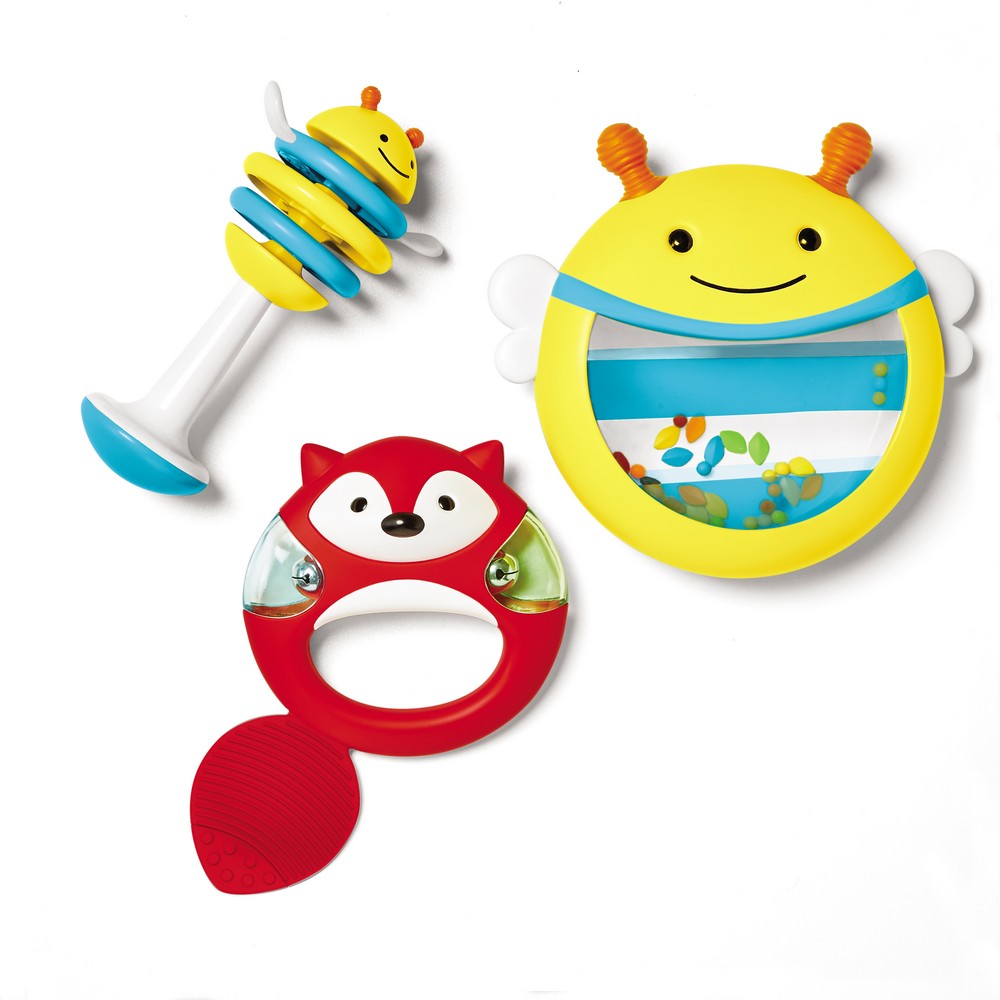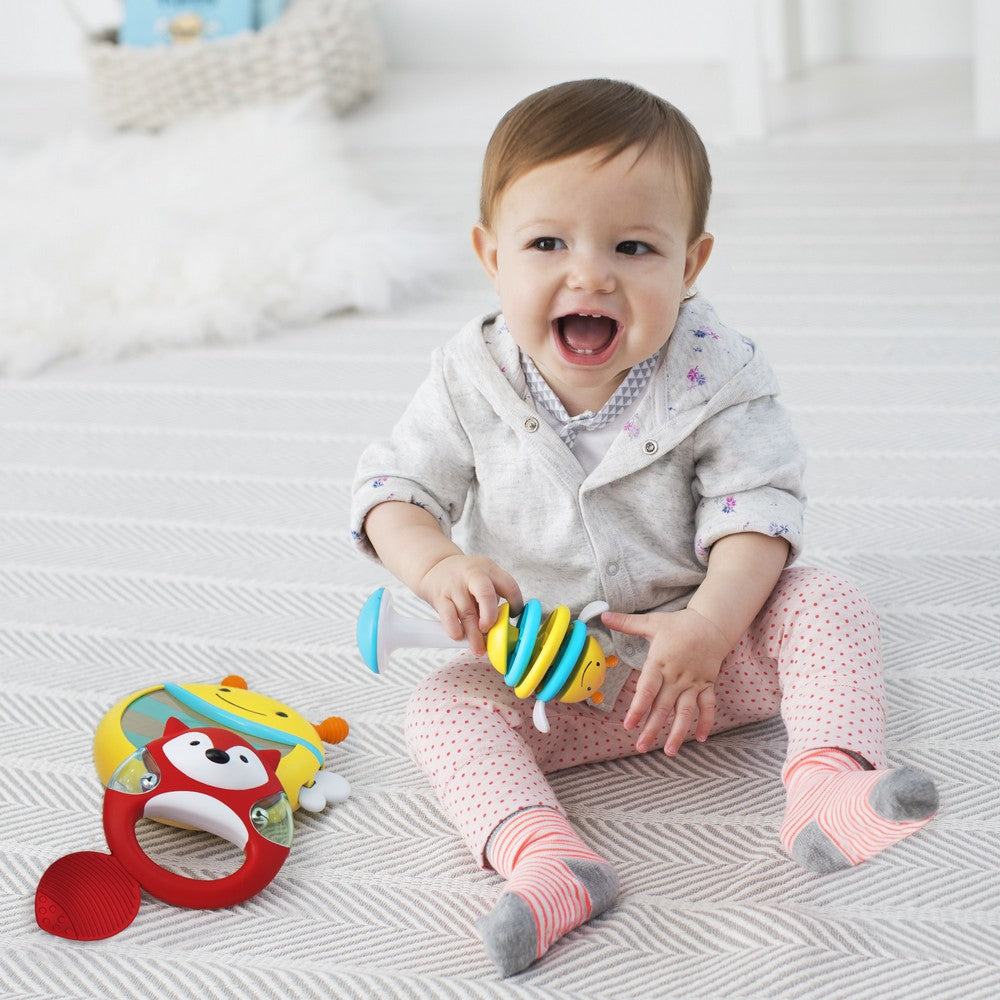Explore & More Musical Instrument Set
Explore & More Musical Instrument Set
SKU:SH303253
Out of stock
Couldn't load pickup availability
Overview
Overview
The Explore & More Musical Instrument Set from Skip Hop is the perfect starter kit for budding musicians! Designed with little hands in mind, this adorable set includes three colorful instruments: a Bee hand drum, a Fox tambourine, and a Bee clacker. Each piece is easy for toddlers to grip and play, helping them explore rhythm, sound, and self-expression.
Whether banging on the drum, shaking the tambourine, or clacking away, kids can enjoy hours of musical fun while developing hand-eye coordination and a love for music. Get ready to rock and roll with Skip Hop's Explore & More Musical Instrument Set—the ideal gift for creative play!
Key Features
Key Features
Technical Specification
Technical Specification
Delivery and Returns
Delivery and Returns
- Delivery: Free within NZ on orders over $100 (excluding bulky items) or $8 standard shipping
- Returns: Accepted within 14 days of receipt with proof of purchase
- Some items are excluded from returns including sale items, hardware, car seats, prams, monitors and personal items - please click here for the full list.
Share this product
Recently Viewed Products
Related Blogs
Music for Babies
Is it a myth or a must? You may have heard that Mozart in utero is essential to healthy brain development, and Baby Einstein on repeat will produce an intellectually advanced toddler. But is music for babies really a thing? Exposing babies and toddlers to music might not necessarily be intelligence-inducing, but it definitely has its benefits for both parents and babies. Here’s what the science really says! Music in utero From around 20 weeks into pregnancy, your baby’s ears start functioning – taking in all the familiar and soothing sounds of the womb and the outside world. That might be mum’s favourite music, the sound of her voice or the constant drum of her heartbeat. So, if classical music isn’t your thing, do you need to suffer through it in the later stages of pregnancy to produce a high IQ human? The jury is out on the intellectual impact of womb-tunes, but listening to music with your unborn babe can be a nice way to schedule some regular time to unwind and bond over your favourite melodies. As a bonus, using this time to de-stress gives you a valid excuse to belt out your greatest hits in the shower. If it makes you feel good, chances are your baby will love it too. While it might be tempting to share an earphone with your belly buddy, playing music through your stereo is a much better option. Amniotic fluid acts as a conductor and can make an earphone too loud for tiny ears. If you’re happy and you know it… We all know that music has the magical ability to transform your mood, and it can do the same for babies and toddlers. Even when they’re little, babies sway or bounce to the beat and can be calmed down with their favourite songs. Using the mood-altering magic of music can also be a helpful way to set up routines for babies and get toddlers on board with chores. Upbeat numbers can get things started in the morning, and special bedtime songs signal to toddlers it’s time to wind down and get ready for sleep. Similarly, music can make chores fun. Rather than asking toddlers to tidy up at the end of the day, take a leaf out of the childcare professionals’ books and learn a ‘clean up’ song – less nagging, more dancing! Learning through music Exposing babies and toddlers to music during their early years helps with learning sounds and the meanings of words. Songs like ‘Heads, shoulders, knees and toes’ expand their vocabularies and coordination, while singing the ABCs teaches sounds and early literacy. On the maths front, popular nursery rhymes are full of repetition, a great way for young brains to learn about patterns and what comes next. Lots of nursery rhymes also include numbers – it’s practically maths for babies! Getting physical Getting their tiny groove on helps toddlers build key motor skills like jumping, balancing and clapping. Body and mind work together as they move to the beat. Spatial awareness and social skills are also learnt through movements like dancing – avoiding bumps and noticing how other toddlers move in group settings. Music for bonding Life as a new parent can be all go, so it’s nice to schedule some regular bonding time and fun with music. If you feel lacking in the creative department, check out what’s on offer at your local library or church – many offer preschool music sessions which double as a great (and easy) opportunity for new mums to escape the house. Ears and imaginations Is there anything better than a toddler who is good at listening? Music cues toddlers to move and react, a great way to develop early listening skills. Similarly, songs that call for them to stomp like a dinosaur or snap like a crocodile sharpen their ability to listen and exercise their creative brains. The best musical instruments for your mini maestro Music doesn’t need to be expensive and can easily cost nothing. Aside from singing (free), other beats like clapping, clicking fingers or stomping are easy (and also free) ways to create music at home. Once you’ve exhausted those, there are plenty of things around the home that can make a serious sound – a good old wooden spoon and pot, or clanging two pot lids together. Looking for something slightly more tuneful? The best instruments for little fingers are things that can be hit or shaken. Think soft rattles for babies, simple wooden drums, maracas or xylophones. Music to your ears The good news is, there’s no real evidence that one type of music is better for your baby’s development than another – but there is evidence that music is a good thing overall. All that really matters is that you’re having fun and enjoying music with your little one. Because if you’re happy (and you know it), chances are your baby will be happy too!
Learn moreBaby Comforters: What Are They, and How To Introduce Them
There’s something very special about watching your baby snuggle into their favourite little blanket or soft toy. For many little ones, a comforter (or blankie) becomes more than just a bedtime accessory - it’s a trusted friend that brings a sense of calm and reassurance through every new stage of growing up.
Learn moreNewborns & Sleep: What to Expect and Survival Tips
Bringing a new baby home is one of life’s most beautiful - and exhausting - adventures. In this blog, Family Sleep & Wellness Coach, Lauren Moran from Little Dreamers, shares her expert advice on newborn sleep in the fourth trimester.
Learn moreYour Wishlist, Made Easy
Creating a gift registry takes the guesswork out of gifting for you and your loved ones. While the journey of pregnancy can come with plenty of challenges, ticking off your shopping list doesn't need to be one of them.
Learn more
















